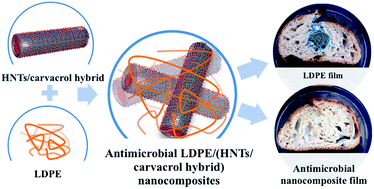Novel LDPE/halloysite nanotube films with sustained carvacrol release for broad-spectrum antimicrobial activity†
Abstract
The emergence of antibiotic resistance of pathogenic bacteria has led to renewed interest in exploring the potential of plant-derived antimicrobials e.g., essential oils (EOs), as an alternative strategy to reduce microbial contamination. However, the volatile nature of EOs presents a major challenge in their incorporation into polymers by conventional high-temperature processing techniques. Herein, we employ halloysite nanotubes (HNTs) as efficient nano-carriers for carvacrol (a model EO). This pre-compounding encapsulation step imparts enhanced thermal stability to the carvacrol, allowing for its subsequent melt compounding with low-density polyethylene (LDPE). The resulting polymer nanocomposites exhibit outstanding antimicrobial properties with a broad spectrum of inhibitory activity against Escherichia coli, Listeria innocua in biofilms, and Alternaria alternata. Their antimicrobial effectiveness is also successfully demonstrated in complex model food systems (soft cheese and bread). This superior activity, compared to other studied carvacrol containing films, is induced by the significantly higher carvacrol content in the film as well as its slower out-diffusion from the hybrid system. Thus, these new active polymer nanocomposites presents an immense potential in controlling microbial contamination and biofilm related adverse effects, rendering them as excellent candidate materials for a wide range of applications.


 Please wait while we load your content...
Please wait while we load your content...